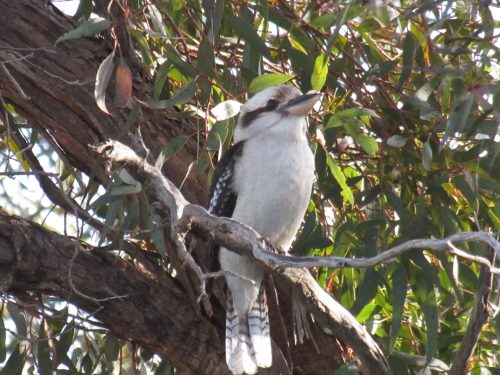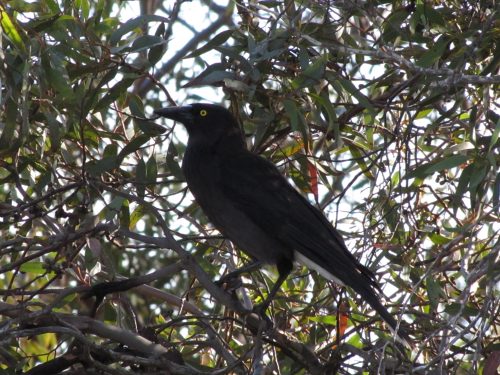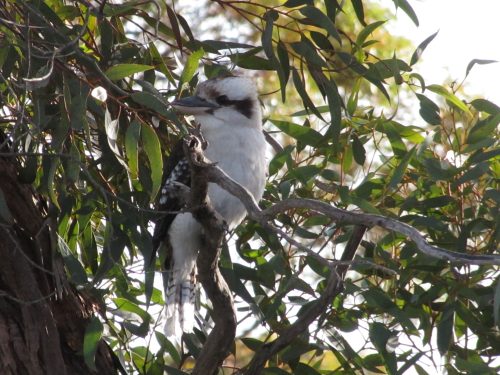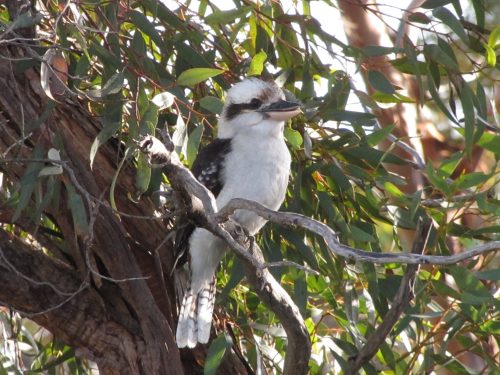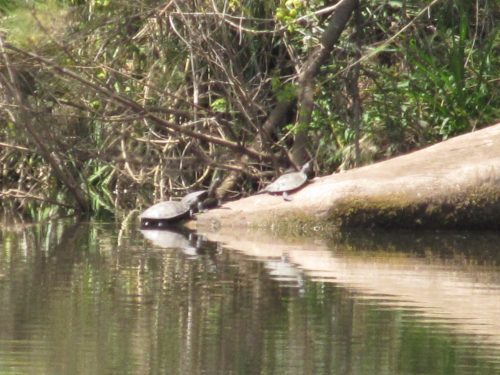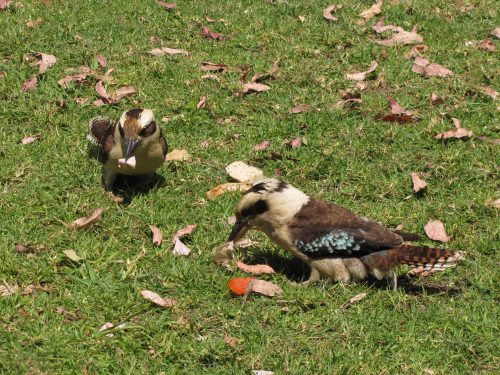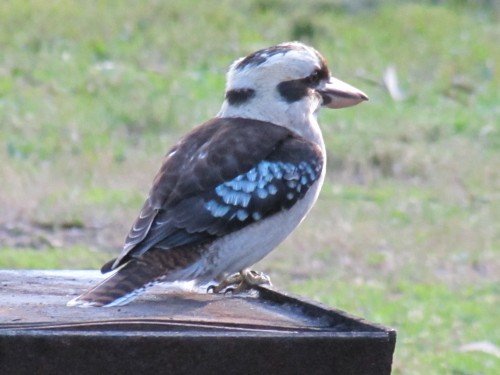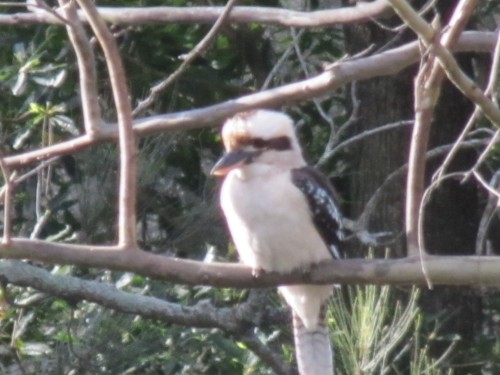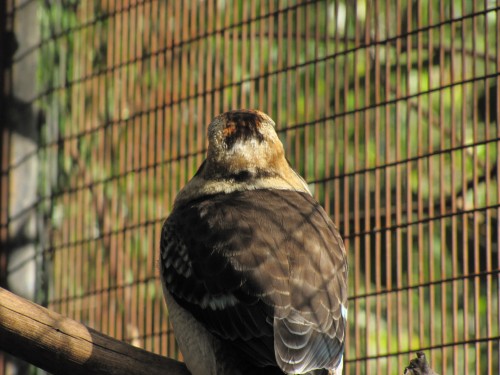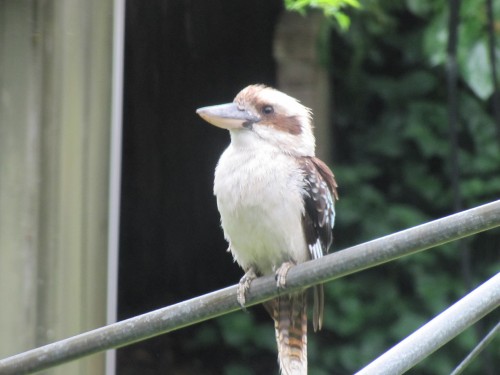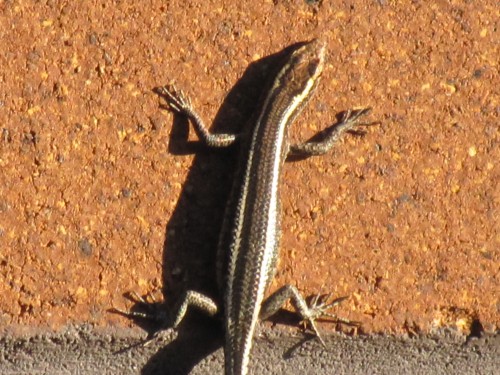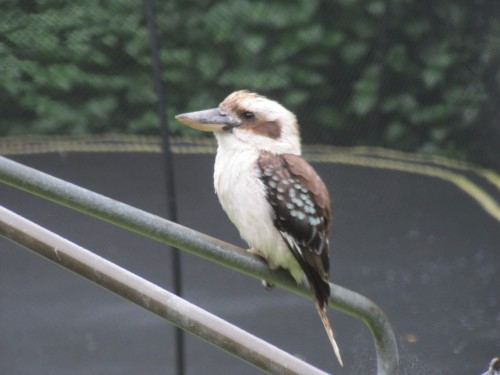An unusual visitor
Garden Birds
On my database, I record the birds I see in our garden, or on our five-acre block, or flying overhead. I have done this every month for well over 30 years now. In more recent times, I have started recording them on a weekly, and sometimes daily, occasions. This has built up a great base of information about the birds we have resident (present every day), regular visitors (every few weeks or months) and occasional (perhaps one or two sightings a year). So far, the tally is over 110 different species. (I don’t know the exact figure because my database is not quite up to date.)
Rare Visitors
Surprisingly, one of the rarer occasional visitors is the Laughing Kookaburra. This species is widespread throughout southern and eastern Australia and is common in many places. It is a widespread species here in the Murray Bridge region of South Australia too, especially along the Murray River. Despite that, it is a rare visitor to our garden. In fact, until a few weeks ago, our last sighting was just over ten years ago.
Harassment
The individual which paid us a recent visit did not have a good time. As I was getting some photos – shown on today’s post – a Grey Currawong kept on harassing it until it flew off in disgust at the poor welcoming party. I guess that the Currawong chased the kookaburra away to discourage it from visiting its nest, though I have not seen any evidence of the Grey Currawongs nesting so far this year. The Currawong itself is not slow about robbing the nests of other birds, either.
Further Reading:
- Grey Currawong – Birds in Backyards site
- Laughing Kookaburra – Birds in Backyards site
- Lunch Snatching Kookaburra
- A Laughing Kookaburra comes to lunch
Lunch snatching birds at Lane Cove National Park
As I write this we are in Sydney visiting our son and his family. We enjoy visiting him because it is a precious time of blessing as we spend time with our two grandchildren, ages eight and five. It is always great to see them growing and developing. During our times here in Sydney we have limited opportunities to go birding, so any free time we have is really appreciated. On this particular trip, we have visited Lane Cove National Park on several occasions, both times for lunch. This national park is only about ten minutes away by car, depending on the volume of traffic and time of day.
On a recent visit, we set up our folding chairs in a shady spot with a good view of the river. We placed our picnic lunch on the side table of our chairs. Before we could take a bite I observed two Long-necked Turtles sunning themselves on a log protruding from the water (see photo above). I handed my binoculars to my wife so that she could have a closer look at them.
That was when we were robbed!
A cheeky Laughing Kookaburra swooped down from a nearby branch. It snatched a part of my wife’s sandwich and flew off with it. As it dropped the sandwich makings on the grass nearby, another kookaburra flew down to share in this ill-gotten booty. Not long after this, as they were squabbling over their prize, a Noisy Miner joined in the fun. Noisy Miners are one of our native honeyeater species; they can be quite aggressive towards smaller birds and they are obviously quite at home matching it with the much larger kookaburras.
My wife was incensed. She had lost a portion of her lunch to a thieving bird. Later, she read a small plaque on one of the park picnic tables. In fact, all tables have copies of the same message: “Visitors are asked not to feed the birds and animals” or words to that effect. Perhaps the rangers should also put up signs instructing the local wildlife not to snatch human food.
Naturally, we guarded the rest of our lunch very carefully. No sense in losing any more of it. A few minutes later, two Brush-turkeys came mooching around. They looked as if they also wanted a handout. In fact, I held out my empty palm towards one of them and it approached to within a few centimetres of my hand. It left disappointed.
Please do not feed the birds
I think it would be prudent of me to make mention of the fact that it is strongly recommended that people in parks, gardens and even their own gardens refrain from feeding our native birds. Most human food – especially bread – is actually quite dangerous – even deadly – for our birds. By all means, provide fresh drinking water in a birdbath, but resist the desire to feed them. It’s for their welfare.
Good birding,
Trevor
PS Go to below the comments section to subscribe to my monthly newsletter. These newsletters will contain extra news items and special insights and photos not available in my regular posts.
One hot bird?
Near the end of our recent visit to the Lane Cove National Park in Sydney I saw this Laughing Kookaburra, first on a branch of a nearby tree (see below), and then on a nearby barbecue plate.
Fortunately nobody had been to that barbecue to cook their lunch that day, otherwise we would have had one very hot bird!
On a more serious note: once several decades when cooking a barbecue lunch for my family in Western Australia a kookaburra swooped out of a nearby tree and grabbed a sausage from the hot plate. I was not happy at the time, but in recent years I delight in telling this little story.
By the way, Laughing Kookaburras are not native to WA; they were introduced in the 1890s and have spread over much of south west Western Australia. On the other hand, Blue-winged Kookaburras can be found in the northern parts of WA.
Further reading:
- Laughing Kookaburra comes to lunch – an account of another kookaburra seeking human food – also in the Lane Cove National Park a few years ago.
A rude Laughing Kookaburra
Most people love to hear the call of the Laughing Kookaburra. It is one of the quintessential bird calls of the Australian bush.
Some people might be of the opinion that Laughing Kookaburras can be quite rude when they laugh at inappropriate moments. The bird in the photo above was being rude in a quite different way; he turned his back on me.
The bird shown in the photo today was one of the residents of one of the walk through aviaries at the Australian Reptile Park near Gosford north of Sydney. We went there on a family outing recently. It is my guess that there were also many more kookaburras in the surrounding bushland.
I’d better own up. The bird in the photo did turn around shortly after this photo was taken. Unfortunately I didn’t get the focus right and it turned out quite blurred, so I guess you can say that I was the rude one – for calling it rude in the first place!
Laughing Kookaburra, Artarmon
Over Christmas last year we stayed with family in Artarmon on the north shore in Sydney. Almost every day we heard Laughing Kookaburras somewhere near the house, usually around 4:30am every morning. It was a pleasant wake-up call, albeit a little early.
From time to time my family enjoys seeing a kookaburra visit their back yard, often perching on the clothes line. I guess that they enjoy visiting and picking up for lunch any small skink (a small lizard – see photo below) that is a little tardy in moving to shelter out of sight.
Update Oct 1st 2015: I have recently been talking on the phone with my 7 year old grandson several times a week in recent weeks. He has developed an interest in the local birds (I wonder where he developed that interest?). He has told me that he regularly sees and hears the kookaburras in his garden, in the street where they live and in nearby parks where he goes riding his bike. On enquiring about the resident skinks, he told me that they see many of them every day they are in the garden, but the blue-tongue lizard which used to live under their front steps is no longer there.
For a discussion on the identification of the skink, please read the comments.
Further reading:
- A Laughing Kookaburra comes to lunch
- Interrupted by a Kookaburra
- The skink I referred to is a Common Garden Skink Lampropholis guichenoti
Article updated 1st October 2015.
